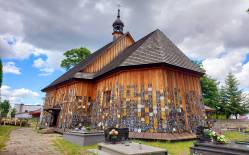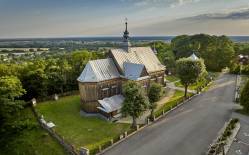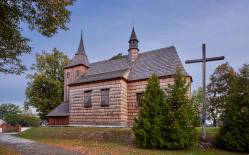Church of St. Anne was built from larch wood in 1580–1583. In 1581 an alms-house and a parish school were built near the church. During 1585–1590, when the local estate was acquired by Marcin Gniewosz who converted to Calvinism, Church of St. Anne temporarily became a seat of the Catholic parish since the former parish church in Zdziechowice was also taken over by Calvinists. The Reformed commune was closed down around 1594, however the church in Zdziechowice was destroyed by fire, and St. Anne’s Church for some time was the only one in the area. Soon a new large brick church of the Holy Trinity, founded by the widow of Marcin Gniewosz, Anna, was built in Zaklików. A new parish was established here.
Church of St. Anne is a one-nave structure with stone foundations and walls clad with vertical wood planks. The building is covered with a shingled gable roof, slightly lower over the chancel. Over the nave there is a bell turret. Along the northern wall there is an annex structure where coffins are stored before burial. The sacristy, the annex and the porch were added in the 1800s.
The nave and the chancel feature barrel vaults. The rood beam supports a cross from the 1700s. Pipe organs are located on the gallery.
Inside there are three altars: the high altar with a 17th century representation of Virgin and Child with Saint Anne and two side altars – one from the late 1600s with a picture of St. Joseph and the other from the early 1700s with a representation of an unknown cardinal. There is also a pulpit from the late 1700s/early 1800s. The walls inside are painted in white. On the walls we can see a number of paintings – votive offerings made by townspeople of Zaklików.
Today the church is used as a cemetery chapel.
There is an interesting custom to attach funerary plaques to the outer walls of the church in memory of those buried in this cemetery.
In the main square we can see an authentic border-post marking the former dividing line between Galicia and Congress Poland.
Photo: Podkarpackie Regional Tourist Board
Gallery

Recommended venues on the Trail



This website has been modernized with the financial support of the European Union under the Cross-Border Cooperation Programme Poland-Belarus-Ukraine 2014-2020. The responsibility for its content lies solely with the Podkarpackie Regional Tourism Board and cannot, in any case, be treated as a reflection of the position of the European Union, the Managing Authority, or the Joint Technical Secretariat of the Cross-Border Cooperation Programme Poland-Belarus-Ukraine 2014-2020.













